INSTITUT SUPERIEUR D'ANTHROPOLOGIE
INSTITUTE OF ANTHROPOLOGY
ONLINE COURSES / COURS A DISTANCE
SUMMER TERM : JULY 2014
REGISTER NOW
ROYAUME UNI – 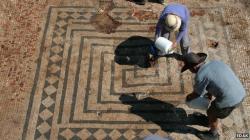 Puddletown-Work is due to begin on unearthing two mosaics discovered at the site of a Roman villa in the Dorset countryside. The first signs of the mosaics were spotted last year at the site near Puddletown which is being excavated by volunteers. The mosaics which are due to be fully uncovered are thought to be part of a corridor pavement or a room floor. Archaeological studies of the 100m by 200m (330ft by 660ft) site near Druce Farm, began in 2012 after geophysical surveys revealed the presence of a villa complex. A large floor mosaic was discovered during a dig last year. Volunteers are set to work through the summer on two trenches to fully reveal the more recently discovered mosaics. "To find a pavement is very rare - it's very fortunate it has survived. On first inspection it is very well preserved," said Ms Ladle. The villa is believed to have been inhabited between AD200 and AD500. Pottery, coins and drinking vessels have already been found which indicate it was a "large, high class villa," with buildings surrounding a courtyard. It is close to the Roman town of Durnovaria, modern-day Dorchester. The building's age has been calculated by analysing thousands of barn owl pellets. The birds are thought to have roosted in the building when it became disused.
Puddletown-Work is due to begin on unearthing two mosaics discovered at the site of a Roman villa in the Dorset countryside. The first signs of the mosaics were spotted last year at the site near Puddletown which is being excavated by volunteers. The mosaics which are due to be fully uncovered are thought to be part of a corridor pavement or a room floor. Archaeological studies of the 100m by 200m (330ft by 660ft) site near Druce Farm, began in 2012 after geophysical surveys revealed the presence of a villa complex. A large floor mosaic was discovered during a dig last year. Volunteers are set to work through the summer on two trenches to fully reveal the more recently discovered mosaics. "To find a pavement is very rare - it's very fortunate it has survived. On first inspection it is very well preserved," said Ms Ladle. The villa is believed to have been inhabited between AD200 and AD500. Pottery, coins and drinking vessels have already been found which indicate it was a "large, high class villa," with buildings surrounding a courtyard. It is close to the Roman town of Durnovaria, modern-day Dorchester. The building's age has been calculated by analysing thousands of barn owl pellets. The birds are thought to have roosted in the building when it became disused.
http://www.bbc.com/news/uk-england-dorset-27266690?
INDE - Sree Padmanabhaswamy temple - B. Mohanachandran, in-charge of the Excavations Wing, State Archaeology Department, told The Hindu that the trench excavated early this week had been confirmed as part of a drainage system.“When we resumed our excavation on Friday, we found an urn and associated handmade roof tiles in the trench. Preliminary examination of the earthen items revealed that they were more than 500 years old. The mud inside will have to be scooped out to find whether it was urn burial,” he said. The findings, he said, confirmed that there was human settlement at the site, and further examination needed to be done to ascertain its exact year. The department started excavation at the site after unearthing three steps while digging to install the hydraulic bollards, he said. The steps, red bricks, and slab-like blocks of laterite found inside the trench indicated that there was a proper draining system in place near the temple.
http://www.thehindu.com/news/cities/Thiruvananthapuram/urn-handmade-roof-tiles-unearthed/article5972604.ece
ESPAGNE – 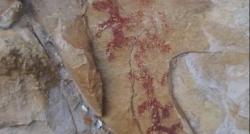 Los Escolares Cave - A 5,000 year-old rock painting in southern Spain has been destroyed by thieves who tried to steal the Unesco World Heritage-listed artwork by chipping it off the cave wall where it was housed. News of the attempted theft first emerged on Saturday after visitors to the Los Escolares Cave noticed the damage to the zoomorphic painting of a person resembling a swallow. After noticing what looked like evidence of someone having tried to chip away at the image with a pick, they spotted fine dust and rock fragments on the floor.
Los Escolares Cave - A 5,000 year-old rock painting in southern Spain has been destroyed by thieves who tried to steal the Unesco World Heritage-listed artwork by chipping it off the cave wall where it was housed. News of the attempted theft first emerged on Saturday after visitors to the Los Escolares Cave noticed the damage to the zoomorphic painting of a person resembling a swallow. After noticing what looked like evidence of someone having tried to chip away at the image with a pick, they spotted fine dust and rock fragments on the floor.
http://www.thelocal.es/20140421/ancient-rock-paining-in-spain-jaen-cave-prehistoric
CHINE - Rongcheng - Excavations of a Neolithic site dating back more than 5,000 years in north China shows cultural interaction among migrating populations in ancient China, said Chinese archaeologists. The site in Rongcheng County, Hebei Province, covers an area of 1,700 square meters. Thousands of pieces of pottery have been unearthed with red the most common, said Xu Haifeng, a researcher with the Hebei Cultural Heritage Research Institute, on Saturday. The excavated items showed double-ear or tube-shaped pots were popular tools. The cooking equipment was advanced as a "Zeng", or an earthen vessel for steaming food, already existed at that time, said Xu, adding all these revealed the life of ancient people. The site was the forefront of north-south cultural and people exchanges, said Zhang Xiaozheng, head of the excavation team. "We can imagine a branch of people from current Inner Mongolia and Liaoning Province moved southward with red pottery skills while another moved northward from current Henan Province with relatively advanced colored pottery," said Zhang. They met in the area of the relic site, added Zhang. The excavation of the site is still underway.
http://news.xinhuanet.com/english/sci/2014-05/03/c_133307074.htm?
BULGARIE – 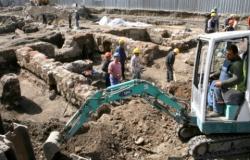 Sofia - Archaeologists are to start in 2015 excavations under Sofia's Sveta Nedelia Square in search of 3 government buildings of the ancient city of Serdica. Field research is set to begin next spring, according to the Bulgarian capital's Deputy Mayor, Todor Chobanov as quoted by the Monitor daily. Chobanov, citing hypotheses among archeologists, explained that the buildings below the square, which lies in the center of Sofia, might have been the residences of city governors or Serdica's mint. The idea that Constantine the Great's Palace might be there has not been ruled out as an option. The Deputy Mayor however said for the public broadcaster BNT on Thursday that socialist architecture in the 1950s and 1960s probably destroyed part of the ancient buildings, as the foundations of the govenrment institutions constructed there went very deep into the ground, and the ruling elite had no interest in preserving ancient cultural heritage. It is often said that the Roman Emperor Constantine the Great (272-337) had a special affection for the city of Serdica, which he reportedly described as "his Rome". Next year's attempt to discover his Palace will not be the first one, though. In 2010, metro construction revived hopes, as construction workers discovered ruins which later turned to be Serdica's public baths.
Sofia - Archaeologists are to start in 2015 excavations under Sofia's Sveta Nedelia Square in search of 3 government buildings of the ancient city of Serdica. Field research is set to begin next spring, according to the Bulgarian capital's Deputy Mayor, Todor Chobanov as quoted by the Monitor daily. Chobanov, citing hypotheses among archeologists, explained that the buildings below the square, which lies in the center of Sofia, might have been the residences of city governors or Serdica's mint. The idea that Constantine the Great's Palace might be there has not been ruled out as an option. The Deputy Mayor however said for the public broadcaster BNT on Thursday that socialist architecture in the 1950s and 1960s probably destroyed part of the ancient buildings, as the foundations of the govenrment institutions constructed there went very deep into the ground, and the ruling elite had no interest in preserving ancient cultural heritage. It is often said that the Roman Emperor Constantine the Great (272-337) had a special affection for the city of Serdica, which he reportedly described as "his Rome". Next year's attempt to discover his Palace will not be the first one, though. In 2010, metro construction revived hopes, as construction workers discovered ruins which later turned to be Serdica's public baths.
http://www.novinite.com/articles/160235/Sofia+Excavations+to+Look+for+Constantine+the+Great%27s+Palace
BULGARIE –  Sapareva Banya - An entirely preserved Roman tomb was discovered in Bulgaria’s south-west resort of Sapareva Banya, the historical museum in the city of Kyustendil announced. During the construction of a private guest house, the workers have found what turned out to be 24 graves, the oldest of which dates back to 4th century AD, Bulgarian National Radio (BNR) reported. An intact plaque was found inside one of the walls. Most likely it was a family tomb, as the archeologists have found the remains of a man, a woman and a child, as well as the remains of cremation. It is assumed that the man was a soldier, because of his military footwear, BNR informs. The architecture of the tomb is intact. Its construction suggests that the owner was a wealthy military of a higher rank, the team of archaeologists has explained. The excavation works involve experts from the town of Samokov.
Sapareva Banya - An entirely preserved Roman tomb was discovered in Bulgaria’s south-west resort of Sapareva Banya, the historical museum in the city of Kyustendil announced. During the construction of a private guest house, the workers have found what turned out to be 24 graves, the oldest of which dates back to 4th century AD, Bulgarian National Radio (BNR) reported. An intact plaque was found inside one of the walls. Most likely it was a family tomb, as the archeologists have found the remains of a man, a woman and a child, as well as the remains of cremation. It is assumed that the man was a soldier, because of his military footwear, BNR informs. The architecture of the tomb is intact. Its construction suggests that the owner was a wealthy military of a higher rank, the team of archaeologists has explained. The excavation works involve experts from the town of Samokov.
http://www.novinite.com/articles/160261/Roman+Tomb+Found+in+Bulgaria%E2%80%99s+Sapareva+Banya+Resort
EGYPTE- 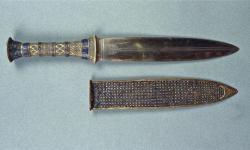 Gerzeh - Five thousand three hundred years ago, a man was buried in a sandy grave in the Gerzeh cemetery, 70km south of modern Cairo, Egypt. Little is known about him, but it is clear that he was important, because of the valuable grave-goods he was buried with – an ivory pot, a copper harpoon, a stone palette to grind cosmetics, and bead jewellery made from gold and iron. But the Egyptian iron age didn't start until 600BC, so what are these iron beads doing here?Although rare, a number of elite people appear to have been buried with pre-Iron Age artefacts, including King Tutankhamun in 1327BC. Wrapped inside his mummy bandages was a dagger with a sharp iron blade and an iron amulet on a gold bracelet. Were the ancient Egyptians working iron far earlier than we thought? Did it arrive in Egypt via trade or, as the earliest archaeologists suggested, did the iron come from meteorites? Using electron microscopy to scrutinise the surface and micro x-ray computer tomography to examine inside the Gerzeh beads, Diane Johnson from the Open University and Joyce Tyldesley from the University of Manchester have shown that for the beads at least, the structure and nickel-rich chemistry of the iron suggests a meteoric origin. An iron meteorite impact crater, discovered in southern Egypt in 2008 and dated to within the last 5000 years, could have been the source of some early iron, which was perhaps considered special because it 'fell from the sky', the home of the gods.
Gerzeh - Five thousand three hundred years ago, a man was buried in a sandy grave in the Gerzeh cemetery, 70km south of modern Cairo, Egypt. Little is known about him, but it is clear that he was important, because of the valuable grave-goods he was buried with – an ivory pot, a copper harpoon, a stone palette to grind cosmetics, and bead jewellery made from gold and iron. But the Egyptian iron age didn't start until 600BC, so what are these iron beads doing here?Although rare, a number of elite people appear to have been buried with pre-Iron Age artefacts, including King Tutankhamun in 1327BC. Wrapped inside his mummy bandages was a dagger with a sharp iron blade and an iron amulet on a gold bracelet. Were the ancient Egyptians working iron far earlier than we thought? Did it arrive in Egypt via trade or, as the earliest archaeologists suggested, did the iron come from meteorites? Using electron microscopy to scrutinise the surface and micro x-ray computer tomography to examine inside the Gerzeh beads, Diane Johnson from the Open University and Joyce Tyldesley from the University of Manchester have shown that for the beads at least, the structure and nickel-rich chemistry of the iron suggests a meteoric origin. An iron meteorite impact crater, discovered in southern Egypt in 2008 and dated to within the last 5000 years, could have been the source of some early iron, which was perhaps considered special because it 'fell from the sky', the home of the gods.
http://www.theguardian.com/science/2014/may/02/terrawatch-ancient-egypt-iron-meteorite
CHYPRE – 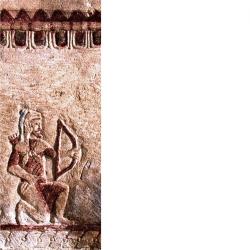 Paleopaphos - Paphos (Palaipaphos), one of the most ancient cities of Cyprus and a place inherently linked with the cult of Aphrodite, has been of fundamental importance for the development of Cypriot culture. Although written documentation for the early stages of Paphian history is limited, our knowledge is enriched by the numerous monuments of the city, and new finds brought to light through ongoing archaeological investigations. These finds, which are often impressive in style, are constantly renewing scholarly interest in this major city. “The excavation of cemeteries, especially the one at Kouklia-Skales which was published swiftly, has always been of critical importance for understanding the early history of the Paphian kingdom, its material culture and its social organization. More recent research includes the systematic excavation of a new cemetery at the locality Kouklia-Plakes, new fieldwork at Kouklia-Skales, and smaller-scale investigation in other burial sites dating from the 11th c. BC to the Classical period. “Among the new finds, particularly notable are a number of warrior burials of the so-called ‘heroic’ type. These burials are distinguished by the impressive wealth of their contents and the elaborate rituals performed in honour of the dead. The practices observed in several warrior graves of the Geometric and Archaic periods refer clearly to customs mentioned in the Homeric epics. A similar dependence of epic tradition is identified on a larnax of the Classical period, the decoration of which is obviously inspired by Homeric narratives. “The quantity and quality of the new finds reveal the high level of material culture, art and technology in early Paphos. At the same time it allows for a reappraisal of questions concerning the historical development of the city, the structure of the local society and its affinity with other areas in the Mediterranean.”
Paleopaphos - Paphos (Palaipaphos), one of the most ancient cities of Cyprus and a place inherently linked with the cult of Aphrodite, has been of fundamental importance for the development of Cypriot culture. Although written documentation for the early stages of Paphian history is limited, our knowledge is enriched by the numerous monuments of the city, and new finds brought to light through ongoing archaeological investigations. These finds, which are often impressive in style, are constantly renewing scholarly interest in this major city. “The excavation of cemeteries, especially the one at Kouklia-Skales which was published swiftly, has always been of critical importance for understanding the early history of the Paphian kingdom, its material culture and its social organization. More recent research includes the systematic excavation of a new cemetery at the locality Kouklia-Plakes, new fieldwork at Kouklia-Skales, and smaller-scale investigation in other burial sites dating from the 11th c. BC to the Classical period. “Among the new finds, particularly notable are a number of warrior burials of the so-called ‘heroic’ type. These burials are distinguished by the impressive wealth of their contents and the elaborate rituals performed in honour of the dead. The practices observed in several warrior graves of the Geometric and Archaic periods refer clearly to customs mentioned in the Homeric epics. A similar dependence of epic tradition is identified on a larnax of the Classical period, the decoration of which is obviously inspired by Homeric narratives. “The quantity and quality of the new finds reveal the high level of material culture, art and technology in early Paphos. At the same time it allows for a reappraisal of questions concerning the historical development of the city, the structure of the local society and its affinity with other areas in the Mediterranean.”
http://www.archaiologia.gr/en/blog/2014/05/02/heroic-burials-from-palaipaphos/